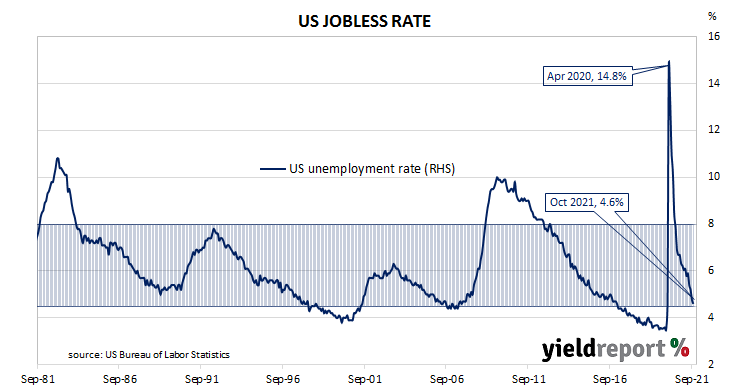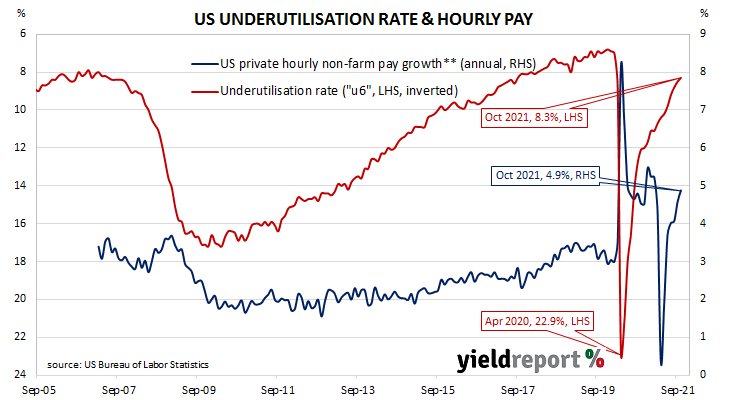Summary: Non-farm payrolls increase by 531K in October; above expectations; previous two months’ figures revised up by 235K; jobless rate down to 4.6%, participation rate steady at 61.6%; labour market recovery “in place”, US economic activity “re-accelerating.”; jobs-to-population ratio increases to 58.8%; underutilisation rate falls from 8.5% to 8.3%; annual hourly pay growth increases to 4.9%.
The US economy ceased producing jobs in net terms as infection controls began to be implemented in March 2020. The unemployment rate had been around 3.5% but that changed as job losses began to surge through March and April of 2020. The May 2020 non-farm employment report represented a turning point and subsequent months provided substantial employment gains. Changes in recent months have been generally more modest but still well above the long-term monthly average.
According to the US Bureau of Labor Statistics, the US economy created an additional 531,000 jobs in the non-farm sector in October. The increase was greater than the 425,000 which had been generally expected earlier in the week and considerably more than the 312,000 jobs which had been added in September after revisions. Additionally, employment figures for August and September were revised up by a total of 235,000.
The total number of unemployed decreased by 255,000 to 7.419 million while the total number of people who are either employed or looking for work increased by 104,000 to 161.458 million. These changes led to a fall in the US unemployment rate from September’s 4.8% to 4.6%. The participation rate remained unchanged from September’s rate of 61.6%.
ANZ economist Rahul Khare said the figures “show that a solid and dynamic labour market recovery is in place and that US economic activity is re-accelerating.” NAB senior economist Tapas Strickland basically agreed, describing the data as “undeniably strong”.
US Treasury yields fell on the day. By the close of business, the 2-year yield had shed 2bps to 0.39%, the 10- year yield had lost 8bps to 1.45% while the 30-year yield finished 7bps lower to 1.89%.
One figure which is indicative of the “spare capacity” of the US employment market is the employment-to-population ratio. This ratio is simply the number of people in work divided by the total US population. It hit a cyclical-low of 58.2 in October 2010 before slowly recovering to just above 61% in late-2019. October’s reading inched up from 58.7% to 58.8%, still some way from its April 2000 peak reading of 64.7%.
Wage growth spiked in the US during the early stages of pandemic restrictions as lower-paid jobs disappeared at a faster rate relative to higher-paid jobs, disrupting the usual relationship between wage inflation and unemployment rates. Normally, wages tend to grow as the supply of labour tightens.
One measure of tightness in the labour market is the underutilisation rate. In October, this measure declined from 8.5% to 8.3%. Hourly pay growth over the previous 12 months accelerated from September’s revised rate of 4.6% to 4.9%.



